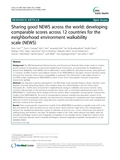Mostrar el registro sencillo del ítem
Sharing good NEWS across the world: developing comparable scores across 12 countries for the neighborhood environment walkability scale (NEWS)
| dc.creator | Cerin, Ester | es_ES |
| dc.creator | Conway, Terry L. | es_ES |
| dc.creator | Cain, Kelli L. | es_ES |
| dc.creator | Kerr, Jacqueline | es_ES |
| dc.creator | Bourdeaudhuij, Ilse de | es_ES |
| dc.creator | Owen, Neville | es_ES |
| dc.creator | Reis, Rodrigo S. | es_ES |
| dc.creator | Sarmiento, Olga L. | es_ES |
| dc.creator | Hinckson, Erica A. | es_ES |
| dc.creator | Salvo, Deborah | es_ES |
| dc.creator | Christiansen, Lars Breum | es_ES |
| dc.creator | MacFarlane, Duncan | es_ES |
| dc.creator | Davey, Rachel | es_ES |
| dc.creator | Mitas, Josef | es_ES |
| dc.creator | Aguinaga Ontoso, Inés | es_ES |
| dc.creator | Sallis, James F. | es_ES |
| dc.date.accessioned | 2015-09-30T07:35:26Z | |
| dc.date.available | 2015-09-30T07:35:26Z | |
| dc.date.issued | 2013 | |
| dc.identifier.issn | 1471-2458 | |
| dc.identifier.uri | https://hdl.handle.net/2454/18329 | |
| dc.description.abstract | Background: The IPEN (International Physical Activity and Environment Network) Adult project seeks to conduct pooled analyses of associations of perceived neighborhood environment, as measured by the Neighborhood Environment Walkability Scale (NEWS) and its abbreviated version (NEWS-A), with physical activity using data from 12 countries. As IPEN countries used adapted versions of the NEWS/NEWS-A, this paper aimed to develop scoring protocols that maximize cross-country comparability in responses. This information is also highly relevant to non-IPEN studies employing the NEWS/NEWS-A, which is one of the most popular measures of perceived environment globally. Methods: The following countries participated in the IPEN Adult study: Australia, Belgium, Brazil, Colombia, Czech Republic, Denmark, Hong Kong, Mexico, New Zealand, Spain, the United Kingdom, and the United States. Participants (N = 14,305) were recruited from neighborhoods varying in walkability and socio-economic status. Countries collected data on the perceived environment using a self- or interviewer-administered version of the NEWS/NEWS-A. Confirmatory Factor Analysis (CFA) was used to derive comparable country-specific measurement models of the NEWS/NEWS-A. The level of correspondence between standard and alternative versions of the NEWS/NEWS-A factor-analyzable subscales was determined by estimating the correlations and mean standardized difference (Cohen’s d) between them using data from countries that had included items from both standard and alternative versions of the subscales. Results: Final country-specific measurement models of the NEWS/NEWS-A provided acceptable levels of fit to the data and shared the same factorial structure with six latent factors and two single items. The correspondence between the standard and alternative versions of subscales of Land use mix – access, Infrastructure and safety for walking/cycling, and Aesthetics was high. The Brazilian version of the Traffic safety subscale was highly, while the Australian and Belgian versions were marginally, comparable to the standard version. Single-item versions of the Street connectivity subscale used in Australia and Belgium showed marginally acceptable correspondence to the standard version. Conclusions: We have proposed country-specific modifications to the original scoring protocol of the NEWS/NEWS-A that enhance inter-country comparability. These modifications have yielded sufficiently equivalent measurement models of the NEWS/NEWS-A. Some inter-country discrepancies remain. These need to be considered when interpreting findings from different countries. | en |
| dc.format.mimetype | application/pdf | en |
| dc.language.iso | eng | en |
| dc.publisher | BioMed Central | en |
| dc.relation.ispartof | BMC Public Health 2013, 13:309 | en |
| dc.rights | © 2013 Cerin et al.; licensee BioMed Central Ltd. This is an Open Access article distributed under the terms of the Creative Commons Attribution License (http://creativecommons.org/licenses/by/2.0), which permits unrestricted use, distribution, and reproduction in any medium, provided the original work is properly cited. | en |
| dc.rights.uri | http://creativecommons.org/licenses/by/2.0/ | |
| dc.subject | Built environment | en |
| dc.subject | Questionnaire | en |
| dc.subject | Global | en |
| dc.subject | Confirmatory factor analysis | en |
| dc.subject | Pooled analyses | en |
| dc.title | Sharing good NEWS across the world: developing comparable scores across 12 countries for the neighborhood environment walkability scale (NEWS) | en |
| dc.type | info:eu-repo/semantics/article | en |
| dc.type | Artículo / Artikulua | es |
| dc.contributor.department | Ciencias de la Salud | es_ES |
| dc.contributor.department | Osasun Zientziak | eu |
| dc.rights.accessRights | info:eu-repo/semantics/openAccess | en |
| dc.rights.accessRights | Acceso abierto / Sarbide irekia | es |
| dc.identifier.doi | 10.1186/1471-2458-13-309 | |
| dc.relation.publisherversion | https://dx.doi.org/10.1186/1471-2458-13-309 | |
| dc.type.version | info:eu-repo/semantics/publishedVersion | en |
| dc.type.version | Versión publicada / Argitaratu den bertsioa | es |
Ficheros en el ítem
Este ítem aparece en la(s) siguiente(s) colección(ones)
La licencia del ítem se describe como © 2013 Cerin et al.; licensee BioMed Central Ltd. This is an Open Access article distributed under the terms of the Creative Commons Attribution License (http://creativecommons.org/licenses/by/2.0), which permits unrestricted use, distribution, and reproduction in any medium, provided the original work is properly cited.



